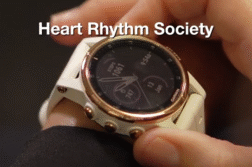CHICAGO, Ill. (Ivanhoe Newswire) – One in 18 people in the U.S. have a heart arrhythmia. A recent study suggests that one in four adults over the age of 40 could develop an irregular heartbeat. Some people will know they have it, others won’t until it’s too late. Now, doctors have a more precise way to diagnose and treat it all at the same time.
A healthy heart beats up to a hundred times a minute. But if that increases or decreases, you may suffer from a heart arrhythmia, caused by breakdowns in the electrical pathways of the heart.
Professor of Medicine and Electrophysiologist at Northwestern Medicine, Dr. Rod Passman, MD, explains, “Some can cause the heart muscle to weaken, and you could develop heart failure, and some can predispose you to stroke.”
Traditionally, doctors diagnose these disorders with an EKG, then medications, or an ablation is performed. But now, Northwestern Medicine doctors are among the first in the country to use a new advanced 3D mapping system.
“By sending magnetic signals through the body, we could recreate a three-dimensional animation of your heart,” Dr. Passman further explains.
Previous technology mapped a few dozen points within the heart. The new technology can map tens of thousands of points in just a few minutes, pinpointing the problem down to the millimeter.
Dr. Passman says, “We can then develop a very personalized approach to your abnormal rhythm.”
A catheter is inserted through a tiny incision and snaked through the blood vessel in the groin. Doctors either heat or freeze the abnormal tissue, sending the heart back into a normal rhythm.
“We can perform your ablations faster, safer, and more effectively, and hopefully, restore you to a higher quality life than you had before,” Dr. Passman reassures.
Men are at a slightly higher risk for heart arrhythmia. There are also things we do to reduce the risk including weight loss, frequent exercise, minimizing alcohol intake, and treating other disorders such as sleep apnea. Anyone over the age of 65, especially those who have diabetes or high blood pressure, should be checked every year for abnormal heart rhythms.
Contributors to this news report include: Marsha Lewis, Producer; Roque Correa, Videographer & Editor.
To receive a free weekly e-mail on medical breakthroughs from Ivanhoe, sign up at: http://www.ivanhoe.com/ftk
Source:
https://www.scripps.org/sparkle-assets/documents/heart_rhythm_facts.pdf
MEDICAL BREAKTHROUGHS
RESEARCH SUMMARY
TOPIC: 3D MAPPING TO FIND AND TREAT HEART ARRYTHMIA
REPORT: MB #5092
BACKGROUND: A heart arrhythmia is an irregular heartbeat. Heart rhythm problems occur when the electrical signals that coordinate the heart’s beats don’t work properly. The faulty signaling causes the heart to beat too fast (tachycardia), too slow (bradycardia) or irregularly. Approximately one in 18 people, or 5 percent of the U.S. population has an arrhythmia. A recent study has also suggested that one in four adult Americans over the age of 40 could develop an irregular heartbeat.
(Sources: https://www.mayoclinic.org/diseases-conditions/heart-arrhythmia/symptoms-causes/syc-20350668
https://www.scripps.org/sparkle-assets/documents/heart_rhythm_facts.pdf
DIAGNOSING: Arrhythmia can produce a broad range of symptoms and results. Your experience with arrhythmia may also differ depending on the type. For instance, a single premature beat may be felt as a “palpitation” or a “skipped beat.” Premature beats that occur often or in rapid succession may increase awareness of heart palpitations or a “fluttering” sensation in the chest or neck. When arrhythmias (including AFib) last long enough to affect how well the heart works, more serious symptoms may develop fatigue or weakness, dizziness or lightheadedness, rapid heartbeat or pounding in the chest, shortness of breath and anxiety, and chest pain or pressure.
(Source: https://www.heart.org/en/health-topics/arrhythmia/symptoms-diagnosis–monitoring-of-arrhythmia)
NEW TECHNOLOGY: New technologies and therapies for treatment of cardiac arrhythmia include ablation catheters designed to destroy targeted tissue with improved precision and safety, robotic systems to guide accurate catheter movements, electrical mapping systems, and improved imaging to complement such systems. San Diego, California-based Vektor Medical is looking to offer an alternative. It announced last week that University of California, San Diego Health is the first hospital to use its FDA cleared vMap technology for mapping the heart during cardiac ablation procedures. Through ablation, heat or cold therapy is applied through a catheter to block irregular electric signals with the goal to restore a typical heartbeat. Vektor Medical claims that its vMap technology is non-invasive, fast, and less labor intensive than current catheter mapping methods. The technology is able to identify potential arrhythmia sources anywhere in the heart using only the data from an ECG to do so.
FOR MORE INFORMATION ON THIS REPORT, PLEASE CONTACT:
Megan McCann
(321) 926-5900
If this story or any other Ivanhoe story has impacted your life or prompted you or someone you know to seek or change treatments, please let us know by contacting Marjorie Bekaert Thomas at mthomas@ivanhoe.com




